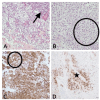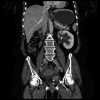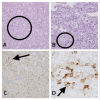Metachronous Metastatic Renal Cell Carcinoma (RCC) to the Urinary Bladder: A Rare Cause of Hematuria
- PMID: 40352014
- PMCID: PMC12065544
- DOI: 10.7759/cureus.82023
Metachronous Metastatic Renal Cell Carcinoma (RCC) to the Urinary Bladder: A Rare Cause of Hematuria
Abstract
Renal cell carcinoma (RCC) metastasis to the urinary bladder has been a rarely reported clinical entity, and its potential metachronous pathobiological process poses significant challenges in RCC therapy-transforming scenarios. In this case, we share the experience of a female patient who underwent radical nephrectomy in September 2020 and was on regular follow-up. In March 2022, she was found to have right pulmonary metastasis on PET-CT imaging and accordingly underwent right-sided wide local excision of the lung lesion by thoracoscopy in June 2022, which revealed metastatic clear cell RCC. She was kept on immunotherapy as discussed in the tumor board meeting and was followed up. Uncommonly, in November 2022, a bladder growth was found involving the left vesicoureteric junction on follow-up CT scan, due to hematuria occurring two years after nephrectomy. Histopathologic examination revealed this mass to be an RCC metastasis. The subsequent imaging diagnosis led to an aggressive treatment approach, resulting in cystectomy with anterior exenteration and ileal conduit. This case is unique in Bahraini literature, as it highlights the unpredictable patterns of RCC metastasis and the infrequent occurrence of the bladder as the site of such metastasis. This report attempts to dissect the intricacies of RCC metastases to the bladder by providing an accurate perspective on diagnosing and managing such atypical sites through a literature review and in-depth discussion of histopathological characteristics. It highlights the importance of an aggressive follow-up regimen for RCC patients, potentially irrespective of their primary site appearing well contained. It would add to our understanding of a broader spectrum of RCC metastatic disease.
Keywords: hematuria; metachronous; metastatic renal cell carcinoma; nephrectomy; urinary bladder.
Copyright © 2025, Asiri et al.
Conflict of interest statement
Human subjects: Consent for treatment and open access publication was obtained or waived by all participants in this study. Conflicts of interest: In compliance with the ICMJE uniform disclosure form, all authors declare the following: Payment/services info: All authors have declared that no financial support was received from any organization for the submitted work. Financial relationships: All authors have declared that they have no financial relationships at present or within the previous three years with any organizations that might have an interest in the submitted work. Other relationships: All authors have declared that there are no other relationships or activities that could appear to have influenced the submitted work.
Figures




Similar articles
-
[RENAL CELL CARCINOMA METASTASIS TO BLADDER DURING MOLECULAR TARGETED THERAPY WITH PAZOPANIB: REPORT OF TWO CASES].Nihon Hinyokika Gakkai Zasshi. 2020;111(2):58-61. doi: 10.5980/jpnjurol.111.58. Nihon Hinyokika Gakkai Zasshi. 2020. PMID: 33883361 Japanese.
-
Metastasis to the Bladder: A Rare Site of Recurrence of Renal Cell Carcinoma.Case Rep Urol. 2022 Jun 17;2022:4339270. doi: 10.1155/2022/4339270. eCollection 2022. Case Rep Urol. 2022. PMID: 35754920 Free PMC article.
-
Rapid metachronous bladder metastasis of type 2 papillary renal cell carcinoma.Arch Clin Cases. 2023 Jun 12;10(2):93-96. doi: 10.22551/2023.39.1002.10249. eCollection 2023. Arch Clin Cases. 2023. PMID: 37313126 Free PMC article.
-
Metachronous bladder metastases of a type 2 papillary renal cell carcinoma: a case report and review of the literature.World J Surg Oncol. 2016 Aug 22;14(1):219. doi: 10.1186/s12957-016-0986-2. World J Surg Oncol. 2016. PMID: 27549183 Free PMC article. Review.
-
Robotic treatment of oligometastatic kidney tumor with synchronous pancreatic metastasis: case report and review of the literature.BMC Surg. 2018 Jun 13;18(1):40. doi: 10.1186/s12893-018-0371-x. BMC Surg. 2018. PMID: 29895293 Free PMC article. Review.
References
-
- Natural history and therapy of metastatic renal cell carcinoma: the role of interleukin-2. Bukowski RM. https://acsjournals.onlinelibrary.wiley.com/doi/full/10.1002/%28SICI%291.... Cancer. 1997;80:1198–1220. - PubMed
-
- Epidemiology of renal cell carcinoma. Padala SA, Barsouk A, Thandra KC, et al. https://pmc.ncbi.nlm.nih.gov/articles/PMC7239575/ World J Oncol. 2020;11:79–87. - PMC - PubMed
-
- A multidisciplinary approach for the management of earlier stage renal cell carcinoma. Molina AM M D. https://www.sciencedirect.com/science/article/abs/pii/S1078143917304982. Urol Oncol. 2018;36:15–16. - PubMed
-
- International Agency for Research on Cancer. World Health Organization Classification of Tumours. Vol. 7. Lyon: IARC Press; 2004. Pathology and genetics of tumours of the urinary system and male genital organs; pp. 148–149.
-
- Renal cell carcinoma: unusual systemic manifestations. Cronin RE, Kaehny WD, Miller PD, Stables DP, Gabow PA, Ostroy PR, Schrier RW. https://journals.lww.com/md-journal/citation/1976/07000/RENAL_CELL_CARCI.... Medicine (Baltimore) 1976;55:291–311. - PubMed
Publication types
LinkOut - more resources
Full Text Sources
